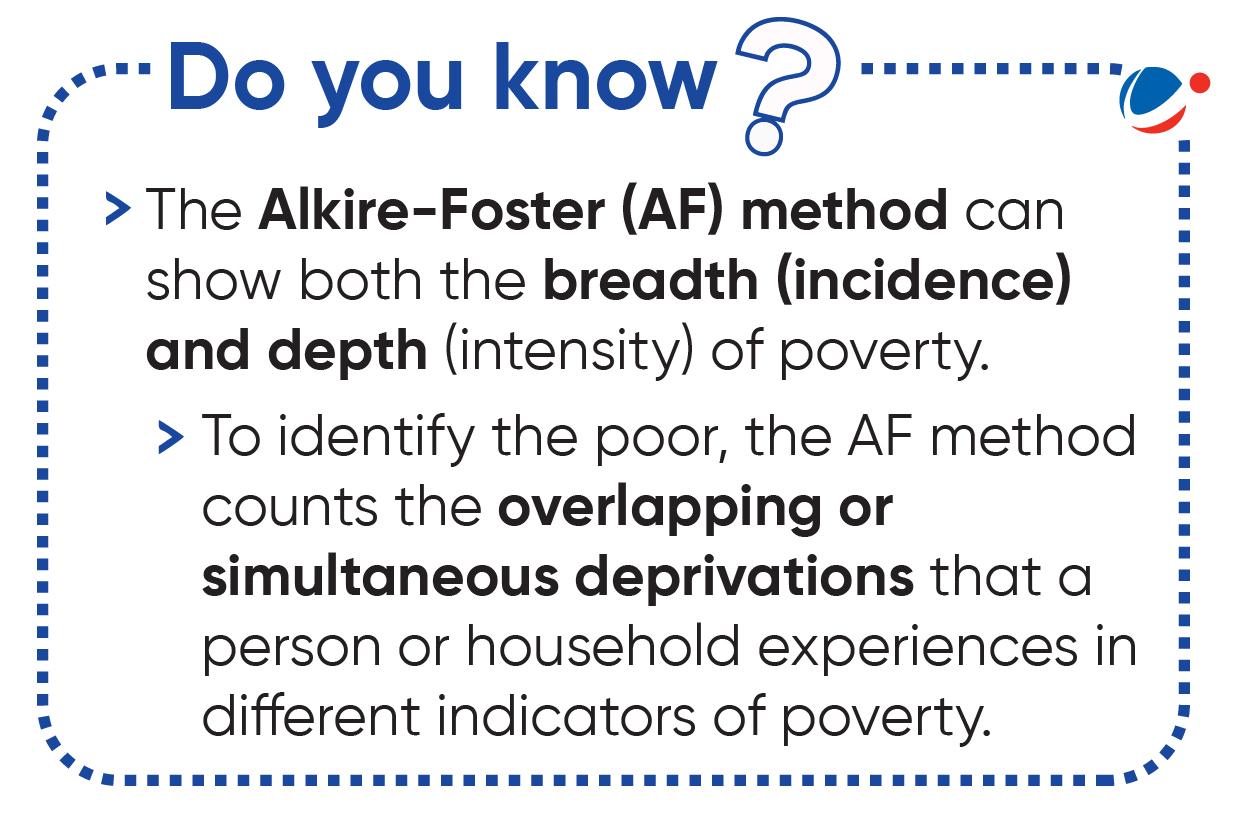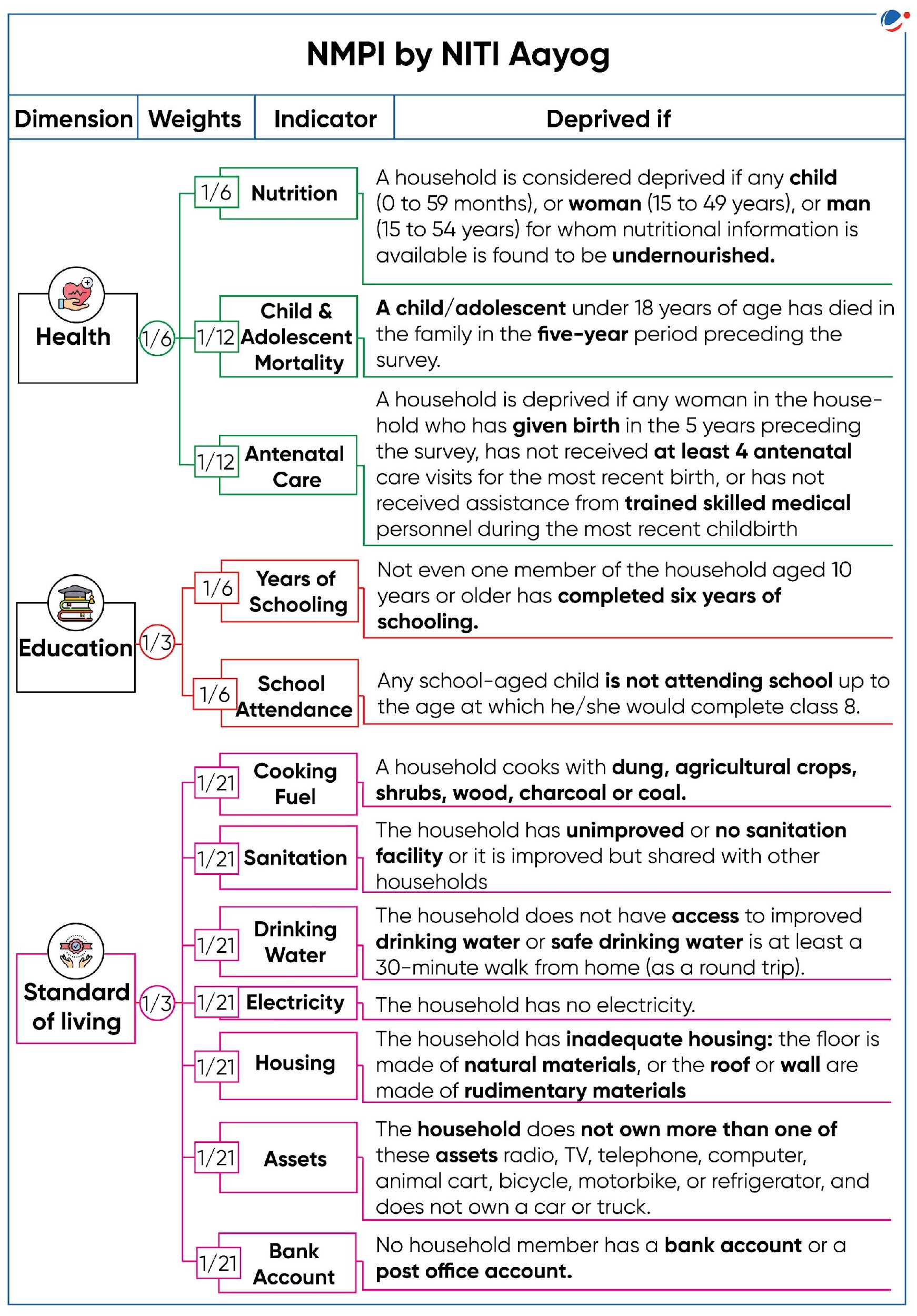Why in the news?
NITI Aayog released a discussion paper titled ‘Multidimensional Poverty in India since 2005-06’.
About Multidimensional poverty
- It refers to a measure that considers various factors or dimensions beyond income to assess and understand poverty.
- Multidimensional poverty encompasses the various deprivations experienced by poor people in their daily lives – such as poor health, lack of education, inadequate living standards, poor quality of work, the threat of violence, among others.
- Ending poverty in all its forms everywhere, the aim of Sustainable Development Goal (SDG) 1, entails viewing poverty not solely in relation to income and consumption, but as relating to other multiple capabilities.

Measurement of multidimensional poverty:
- The Multidimensional Poverty Index (MPI) assesses poverty at the individual level. Alkire-Foster Method is most often used to compute MPIs.
- Global MPI (GMPI): It is a globally recognized comprehensive measure that captures poverty in multiple dimensions beyond monetary aspects.
- GMPI Report was first released by the Oxford Poverty and Human Development Initiative (OPHI) and the United Nations Development Programme (UNDP) since 2010.
- It covers 100 developing countries and captures the acute deprivations in health, education, and living standards that a person faces simultaneously.
- If a person is deprived in a 1/3rd or more of ten (weighted) indicators, the GMPI identifies them as ‘MPI poor.
- National MPI (NMPI): It retains the 10 original indicators of the global MPI model and has added two indicators, viz., Maternal Health and Bank Account, in line with India’s national priorities.
- MPI value is arrived at by multiplying the headcount ratio (H) and the intensity of poverty (A), reflecting both the share of people in poverty and the degree to which they are deprived.
- Headcount ratio (H): It indicates proportion of multidimensionally poor in the population.
- Intensity of poverty (A): It indicates average proportion of deprivations which is experienced by multidimensionally poor individuals.
- Under the government’s Global Indices for Reforms and Growth (GIRG) initiative, NITI Aayog is the nodal agency for MPI.
- GIRG monitors India’s performance on various important social and economic parameters.
- NITI Aayog uses National Family Health Survey (NFHS) to measure the NMPI.
- The latest NMPI, ‘National Multidimensional poverty: A Progress Review -2023’ is based on the data of NFHS 4 and 5.
- MPI value is arrived at by multiplying the headcount ratio (H) and the intensity of poverty (A), reflecting both the share of people in poverty and the degree to which they are deprived.
Key finding of the recent discussion paper
- Decline in MPI: Headcount Ratio decreased from 29.17% in 2013-14 to 11.28% in 2022-23.
- 24.82 crore Indians escaped multidimensional poverty in last 9 years.
- Intensity of Poverty is also declining which shows that extent of deprivation among the deprived population is falling.
- The pace of decline in poverty headcount ratio was much faster between 2015-16 to 2019-21 compared to 2005-06 to 2015-16.
- Poverty declining across indicators: All 12 indicators of MPI have recorded significant improvement.
- Cooking Fuel and Housing have the highest deprivation level of deprivation.
- Child & Adolescent Mortality, Electricity, and Bank Account have the lowest deprivation levels.
- Regional decline in MPI: Poorer states record faster decline in poverty indicating reduction in disparities.
- Uttar Pradesh, Bihar, Madhya Pradesh, Odisha, and Rajasthan saw fastest reduction in the proportion of multidimensional poor.
- Attainment of SDG: India on track to achieve SDG Target 1.2 (reducing multi-dimensional poverty by at least half) much ahead of 2030.
- Factors responsible for decline in MPI: Various government programs including PM Ujjwala Yojana, Saubhagya, and transformative campaigns like Swachh Bharat Mission and Jal Jeevan Mission have collectively elevated living conditions and overall well-being of people.

Significance of NMPI
- Provides for more nuanced perspective as it delves into deprivations up to the district level unlike conventional monetary poverty assessments that is based on consumption surveys.
- Facilitates targeted interventions to address acute poverty and uphold the principle of inclusivity.
- Determination of overlapping deprivations that directly influence individuals’ quality of life and overall well-being.
- Helps in more inclusive policy formulation.
Issues associated with NMPI
- Less sensitive: To be considered multidimensionally poor, households must be deprived in at least 1/3rd of indicators. This requirement makes the MPI less sensitive to minor inaccuracies.
- Impact of COVID-19: Some economists have argued that loss of livelihood due to reverse migration and deaths due to disrupted healthcare in 2020-21 are not covered in the Index.
- Stagnant wages: Real wages were stagnant for six years which had serious implications for consumption demands and this cannot be consistent with a decline in poverty levels.
Way forward
- Include new dimensions in calculating MPI: Like learning outcomes, social discrimination, unorganized workers, environmental degradation etc.
- New measurement: National MPI should incorporate 75th round of National Sample Survey (NSS) data along with NFHS.
- Effective monitoring: Comprehensive measures should be taken to monitor the progress across indicators on real time basis.
- Also, social audit of the programmes, awareness generation about development programme, etc. is critical for eliminating multidimensional poverty.



